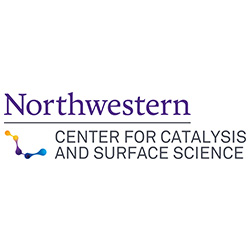CCSS Student Seminar Series

When:
Friday, April 19, 2024
12:00 PM - 1:00 PM CT
Where: Ryan Hall, 2190 Campus Drive, Evanston, IL 60208 map it
Audience: Faculty/Staff - Student - Post Docs/Docs - Graduate Students
Contact:
Kimberly Leroi
Group: Center for Catalysis and Surface Science (CCSS)
Category: Lectures & Meetings
Description:
Center for Catalysis and Surface Science (CCSS) Student Seminar Series
Friday, April 19, 2023 | 12-1pm CT
Ryan Hall, 4003 | 2190 Campus Drive
Lunch provided
Join the Center for Catalysis and Surface Science (CCSS) for the Student Seminar Series. Hear from graduate students and postdoctoral scholars during three presentations. This month's speakers are Fanrui Sha, Dylan Bardgett, and Ray Juneja.
About the Presentations
Speaker: Fanrui Sha
Title: “Enzymatic cascade reducing CO2 into methanol encapsulated in a Cr-based mtn-type mesoporous MOF”
Abstract: The growing CO2 emission from human activities has led to global warming and anthropogenic climate change. Converting CO2 gas into value-added, energy-dense products such as methanol can simultaneously alleviate climate and energy issues. However, the direct reduction of CO2 gas into methanol has been an important yet challenging problem. Most CO2 reduction processes require high temperature and pressure over transition metal-based catalysts, which often require high energy input and result in the generation of undesirable byproducts. Enzymatic conversions occur under ambient pressure and temperature with high efficiency and selectivity, but they often suffer from low protein stability, and their soluble nature renders them unrecoverable as homogenous catalysts. The stability and recyclability of enzyme can be improved through its immobilization onto solid materials, but the design of a porous host with high loading capacity, substrate diffusivity, structural integrity, and water stability is still an area under active exploration. In this work, a chromium-based mesoporous metal–organic framework with cage size up to 6.8 nm (NU-1510-Cr) was developed for the encapsulation of three enzymes, formate dehydrogenase, formaldehyde dehydrogenase, and alcohol dehydrogenase, each responsible for the 2 e- reduction of CO2 into formate, formaldehyde, and methanol. The encapsulation of the three enzymes in NU-1510-Cr aims to enhance the activity, stability, and the recyclability of the enzymatic cascade.
Speaker: Dylan Bardgett
Title: “Care in Catalysis: A case study of transition metal nitride electrocatalysts for ammonia synthesis”
Abstract: In the years following publication of a series of computation articles suggesting transition metal nitrides (TMNs) might be promising catalysts for electrochemical ammonia synthesis, the number of publications involving TMNs and electrochemical ammonia synthesis skyrocketed. Several papers were published suggesting promising initial results. However, at the same time other scientists were calling "Slow down! Be careful about false positives!" It has been almost a decade since research in this field really took off, and we still don't have any beyond-a-shadow-of-a-doubt reports of substantial NH3 synthesis from TMN electrocatalysts. This talk will tell the story of TMN electrocatalysts for ammonia synthesis, the current challenges facing the field, and what we in the Haile lab are doing about overcoming those challenges using intermediate temperature (250°C) solid acid electrochemical devices.
Speaker: Ray Juneja
Title: "Low Temperature Plasma-Assisted Catalysis of Ammonia"
Abstract: Approximately 90% of industrially produced chemicals require catalysts. Ammonia, widely used as a precursor in fertilizer manufacturing, is one of these chemicals. The thermocatalytic Haber-Bosch process utilized to produce ammonia, however, operates at high temperatures and pressures, accounts for 2% of global carbon emissions, and is near its thermodynamic limits. Low temperature plasma (LTP) is an electrified technology that can produce ammonia using renewable energy and at ambient pressures and temperatures. LTP is a highly reactive state of a matter characterized by extremely hot electrons and low temperature neutral, radical, and ionic species. The interaction of heterogeneous nanoscale catalysts (nanocatalysts) with the plasma species is of crucial importance to improve energy efficiency, conversion, and selectivity of ammonia. I am studying the interaction between LTP and various heterogeneous nanocatalysts, specifically nitrides and oxides. The reactions are carried out in a tubular dielectric barrier discharge flow reactor using diatomic nitrogen and hydrogen gases as reactants. Additionally, methane gas is also used in lieu of diatomic hydrogen as a hydrogen donor. The reactions are studied using optical emissions spectroscopy, electrical circuit analysis, and gas chromatography. The catalysts are characterized pre- and post-reaction using powder X-Ray diffraction, surface area analysis, and scanning electron microscopy.
The mission of the Center for Catalysis and Surface Science (CCSS) is to promote interdisciplinary research fundamental to the discovery, synthesis, and understanding of catalysts and catalytic reactions essential to modern society. As a part of the Paula M. Trienens Institute for Sustainability and Energy, CCSS applies fundamental advances in catalysis science towards applications in alternative fuels, abatement of harmful emissions, resource recovery concepts, new processing routes, and many other strategies towards making chemicals more sustainable.